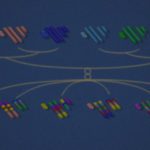Link to Pubmed [PMID] – 9284099
J. Invest. Dermatol. 1997 Sep; 109(3): 324-8
The balding (bal) mutation of the mouse is an autosomal recessive mutation that causes alopecia and immunologic anomalies. A new allele was identified by allelism testing after using an interspecific backcross to localize the mutation to the centromeric end of mouse chromosome 18. We investigated the skin and hair histologic lesions of two alleles (bal(J) and bal(Pas)) at this locus and analyzed the expression of several keratinocyte markers and the production of autoantibodies by immunofluorescence on frozen skin sections. The lesions observed included separation of the inner and outer root sheath in anagen follicles resulting in the hair fiber being very easily plucked from the follicle. Vesicles on the ventral tongue, mucocutaneous junction of the eyelid, foot pads, and rarely in skin were also evident. Separation occurred between the basal and suprabasilar cells forming an empty cleft, resembling that observed in human pemphigus vulgaris. Immunofluorescence studies did not reveal the presence of tissue-bound or circulating autoantibodies. Expression of keratinocyte markers in hair follicles was normal. Keratin 6-positive cells were found on either side of the follicular separation suggesting a molecular defect in adhesion molecules between the inner layer of the outer root sheath cells to layers on either sides. This hypothesis has been confirmed by another group who demonstrated that the bal(J) mutation is due to the insertion of a thymidine in the desmoglein 3 gene, resulting in a premature stop codon.

